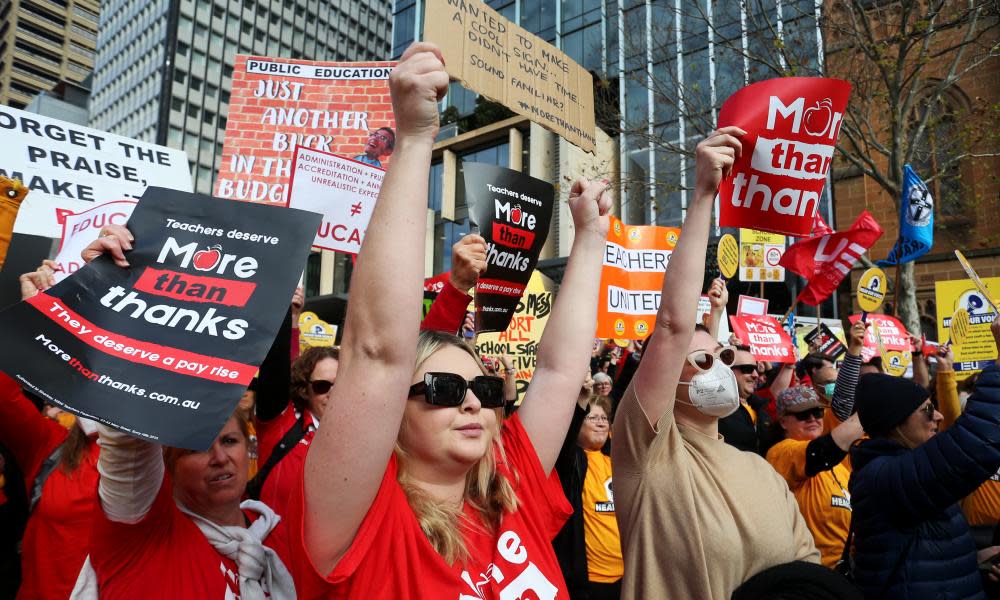NSW teachers should have a 25% pay bump in coming years, research suggests

Wages for New South Wales school teachers should be up to 25% higher before the end of the decade to counter long-term wage suppression and inflation, according to researchers from the University of Sydney who found educators were among the worst-paid professions.
Sign up for Guardian Australia’s free morning and afternoon email newsletters for your daily news roundup
In an update to a 2020 teacher salary report created for the Gallop inquiry into teaching in the state, Prof John Buchanan concluded pay for teachers had gone “from bad to worse, with the situation set to deteriorate further” due to cost-of-living pressures.
The co-director of the university’s Mental Wealth Initiative and his colleagues argue that teachers’ wages should increase by between 15.5% and 25.5% within the next seven years.
“I’ve come to that quantum reluctantly,” Buchanan told Guardian Australia.
“It’s not a reckless figure that’s been put out there. That is a sign of how broken our wages system is.”
Related: NSW Labor pledges $400m for education to ‘end the war on teachers’ if elected
Buchanan argued there had been a further deterioration in earnings in education compared with similar sectors and inflation was putting further pressure on teachers, while workloads were increasing.
“This challenge has been decades in the making,” he said.
“Real earnings today are essentially as they were 10 years ago.”
The report found the difference in wages between teachers and Australians in other professions requiring a degree to practise was “stark” after the age of 40.
“Compared to a number of professionals, teachers are still amongst the lowest paid at all ages,” the report read.
The report found teachers’ jobs had changed over recent decades, making the job harder with an increase in the number of merged or minimal supervision classes and educators being forced to teach outside their expertise areas.
“Adding to the pressure has been a shift towards insecure work, with the bulk of new teachers only engaged as ‘temporaries’,” the report read.
With profits up across many sectors, Buchanan said the government should be looking at ways to tax companies more so that money could be shared with public sector workers.
“Australia is more prosperous today than at any point in our history,” the report said.
“A key problem is that much of our increased prosperity has been unfairly shared.”
Buchanan said the government and taxpayers needed to be looking after those educating our youngest citizens, encouraging the highly unionised workforce to take a stand after repeatedly striking last year.
“They should now be considering playing a central role in setting new standards by working actively with others – the NSW government and industrial tribunals as well as other unions – to address the deeper wages problems in contemporary Australia,” the report concluded.
“This situation will continue unless NSW teachers help establish new bases for a fairer, sustainable approach to their wages.”
The NSW Teachers Federation president, Angelo Gavrielatos, said the teacher shortage was affecting students across the state and wages needed to increase.
“Teacher shortages mean children miss out and teachers burn out,” he said.
He said the government had failed to make sure schools had enough teachers to help children.
Related: Teacher vacancies hit 2,000 across NSW as some schools record 14 unfilled roles
“It is only by addressing the real causes of the teacher shortages – unsustainable workloads and uncompetitive salaries and insecure work – that we can recruit and retain the teachers we need,” Gavrielatos said.
“This crisis will only get worse without immediate action on pay and conditions.”
The push for further action on wages comes amid growing staffing issues around the state.
Department of Education figures obtained by Guardian Australia showed there was one counsellor for every 650 students across the state last August, not accounting for staff on uncovered leave.
In March it was revealed the state was facing a severe secondary teacher shortage, with unreleased federal government modelling suggesting the state would be short-staffed by 1,700 educators within three years.

 Yahoo Movies
Yahoo Movies 
